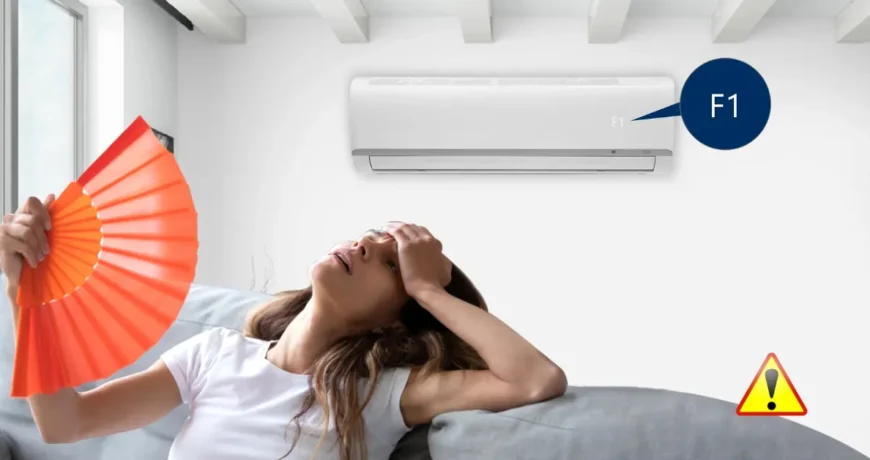No products in the cart.
F1 Error in AC: Causes, Troubleshooting, and Fixes Leave a comment
Is Your Air Conditioner Displaying an F1 Error? Well, don’t worry. Here’s What You Need to Know! Air conditioners are important for comfort, especially during the summer season in Pakistan. However, encountering an F1 error code on your AC unit can be both stressful and complex. Now, the real question is what does this error mean? And how can you resolve it? This extensive guide is best to delve into the reasons of the F1 error in ac, offers troubleshooting steps, and offers effective fixes to revive your air conditioner’s optimal performance.
Understanding the F1 Error Code
The F1 error code alerts to air conditioning system malfunctions that usually arise because of temperature sensor malfunctions. Furthermore, the sensor responsible for temperature monitoring functions as an essential component in room temperature control. When the AC system encounters any issues with the temperature sensor it becomes unable to operate normally which results in the F1 error display. Various air conditioner brands and models may use different symbols for the F1 error code.
Common Causes of the F1 Error
Identifying the root cause of the F1 error is the first step toward effective troubleshooting. Here are some prevalent reasons:
- Faulty Temperature Sensor: A damaged or malfunctioning sensor cannot accurately read room temperature, disrupting the AC’s operation.
- Wiring or Connection Issues: Loose, damaged, or corroded wires connecting the sensor to the main unit can interrupt communication, triggering the error.
- Clogged or Dirty Filters: Accumulated dust and debris on filters can obstruct airflow, causing the system to overheat and display the F1 error.
- Faulty Circuit Board: A malfunctioning circuit board may misinterpret signals from the temperature sensor, leading to erroneous error codes.
- External Temperature Sensor Issues: Problems with the external air temperature sensor, which monitors the air entering the condenser, can also result in the F1 error.
Troubleshooting the F1 Error Code
Before seeking professional assistance, you can perform several troubleshooting steps:
Reset the Air Conditioner:
- Turn off the unit using the remote control or main power switch.
- Wait for approximately 5-10 minutes.
- Restart the AC to see if the error persists.
Inspect the Temperature Sensor:
- Locate the indoor temperature sensor, typically near the evaporator coil.
- Check for visible damage or disconnection.
- Gently clean the sensor with a soft cloth to remove any dust.
Examine Wiring Connections:
- Turn off the power supply before inspecting.
- Ensure all wires connecting the sensor to the circuit board are secure and free from damage.
- Look for signs of wear, corrosion, or loose connections.
Clean or Replace Air Filters:
- Remove filters and wash them with mild detergent and water.
- Allow filters to dry completely before reinstalling.
- Regular cleaning prevents airflow obstruction and system overheating
Check the External Temperature Sensor:
- This sensor monitors the air entering the condenser.
- Ensure it is correctly positioned and free from damage.
- Inspect associated wiring for any issues.
Effective Fixes for the F1 Error
If troubleshooting doesn’t resolve the issue, consider the following solutions:
- Replace the Temperature Sensor: A defective sensor should be replaced with a compatible one specific to your AC model.
- Repair or Replace Faulty Wiring: Damaged wires require professional repair or replacement to ensure proper communication between components.
- Address Circuit Board Issues: If the circuit board is malfunctioning, a qualified technician may need to repair or replace it to restore functionality.
- Resolve External Sensor Problems: If the external temperature sensor is at fault, repositioning or replacing it may be necessary.
Preventive Measures to Avoid Future F1 Errors
Maintaining your air conditioner can prevent recurrence of the F1 error:
- Regular Maintenance: Schedule professional servicing at least once a year to ensure all components function correctly.
- Clean Filters Frequently: Depending on usage, clean or replace filters every 1-2 months to maintain optimal airflow.
- Inspect Wiring Periodically: Regularly check electrical connections for signs of wear or damage.
- Monitor Sensor Performance: Be attentive to your AC’s performance and address minor issues promptly to prevent major malfunctions.
Final Thoughts!
The F1 error in air conditioners normally results from faulty temperature sensors or faulty wiring and obstructed filters. Follow the troubleshooting procedure alongside performing preventive maintenance to fix and minimize this error that harms your AC system operation. Consulting a professional stands as the most suitable approach when the issue continues to persist. By implementing regular maintenance and proper repair appointments your air conditioner will maintain efficiency while ensuring reliability and longevity which provides year-round cooling comfort. Moreover, if you desire to purchase the best quality AC, then do not hesitate and get in touch with us!
Need More Assistance?
If you’re still experiencing issues with the F1 error on your air conditioner, don’t hesitate to seek professional help. For expert advice and a wide range of air conditioning solutions, visit Subhan Electronics!
Frequently Asked Questions (FAQs)
1.Can I Fix the F1 Error on My AC By Myself?
Basic troubleshooting steps like resetting the unit and cleaning filters can be performed independently. However, for sensor or wiring issues, it’s advisable to consult a professional technician.
2. How Much Does it Cost to Repair an F1 Error in an Air Conditioner?
Repair costs vary based on the issue’s severity and the specific AC model. Simple fixes like cleaning may be inexpensive, while sensor or circuit board replacements can be more costly.
3.How Can I Prevent the F1 Error from Occurring in the Future?
Regular maintenance, including cleaning filters, inspecting wiring, and scheduling professional check-ups, can help prevent the F1 error.



